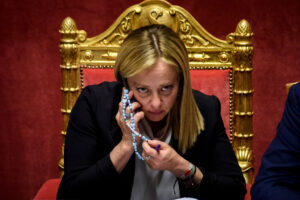At first glance, the Italian constitution reads like soulless legalese: a thicket of jargon and impenetrable articoli. But the power it wields should not be underestimated. La Costituzione dictates the way the peninsula is governed — and, if rewritten as its prime minister desires, could forever change its future.
In November 2023, Giorgia Meloni announced plans to reform Article 92, making the President of the Council of Ministers, otherwise known as prime minister, directly elected by the public. Combined with changes giving the winning party an automatic majority in parliament, Meloni argues her reforms would finally halt her country’s infamous political merry-go-round, a funfair that’s seen Italians endure dozens of governments since 1945.
Given her own political journey, and unpleasant memories of previous constitutional reforms — together, it must be said, with the usual cynicism of politicians everywhere — opposition figures have derided her proposals. Yet if her reforms remain dubiously vague, and may anyway fail to become law, both her backers and critics risk missing the point. From stagnant wages to illegal migration to unstable executives, Italy’s struggles run far deeper than any constitution can hope to solve — and ultimately require genuine action, not theoretical revolutions.
As with so much of modern Europe, Italy’s constitution is a child of 1945. That summer, as a defeated Wehrmacht finally shuffled north, a mix of anti-fascist politicians began debating their country’s political future. The following year, they gathered in the Constituent Assembly, expressly tasked with crafting a new constitution. Reflecting both their ideological spread, and perhaps the presence of foreign troops on Italian soil, members were influenced by a range of foreign models. On the Christian Democratic Right, for instance, Egidio Tosato looked to France and its strong executive rule. Eager to develop a robust judiciary, others borrowed from the Supreme Court in Washington. Given his party’s heritage — and the fact he’d spent much of the war in Moscow — Palmiro Togliatti’s Communists were unsurprisingly inspired by the Soviet Union. Even today, the very first line of Italy’s constitution affirms it as “a Democratic Republic founded on labour”.
But if they disagreed on what the new Italy should be, and ultimately built a constitution that straddled Left and Right, everyone at the Constituent Assembly agreed on avoiding past mistakes. Living amid the literal ruins of Mussolini’s fantasy, they battled, in the words of the long-serving Prime Minister, Alcide De Gasperi, to draft a document where “the law is respected” — especially when they saw constitutional skulduggery as vital to il Duce’s triumph. In 1923, the Italian parliament passed the Acerbo law. Supported by the National Fascist Party, as well as some conservatives and liberals, it gave two-thirds of seats to any party that won 25% of the vote. Combined with violent crackdowns of his enemies on the street, Mussolini exploited this provision ruthlessly. Passing the so-called leggi fascistissime (“most fascist laws”), he banned opposition parties, subsumed parliament to the Grand Council of Fascism, and in 1939 abolished the lower house entirely.
In practice, this history helps to explain the modern Italian constitution. Coming into force in 1948, it strictly limits the authority of any single group. For one thing, the two houses of parliament are co-equal. For another, and per Article 92, the prime minister is appointed by the president, even as the president himself is elected by parliament. That’s echoed by the power of the judiciary: the Constitutional Court is all-powerful when interpreting the constitution, but can only act when granted the relevant authority. The electoral system limited executive power too. Based on proportional representation, and in force until 1993, it boosted the bargaining power of smaller parties.
As the disappearance of the electoral system implies, however, Italy’s constitutional settlement was never truly settled. As early as 1953, for example, De Gaspari’s Christian Democrats passed their own electoral reform. Known to history as the legge truffa (“scam law”), it promised bonus seats to whichever party or coalition won over 50% of votes. Too reminiscent of fascism even for its supporters — shamelessly aimed at increasing the power of the Christian Democrats, the Minister of the Interior supposedly admitted they would soon be known as “swindlers” — the legislation was soon repealed.
Yet with the implosion of the Christian Democrats, alongside other corruption-stained parties through the Nineties, recent decades have seen lawmakers experiment further. Enforceable via regular legislation, electoral changes have been especially popular here. Though some were later judged unconstitutional, 1993, 2005, 2015 and 2017 all saw tweaks to the voting system, each generally aimed at strengthening ruling coalitions. By contrast, thoroughgoing constitutional reform is rather harder to pass. Thanks to the anti-authoritarian legacy of the 1948 document, advocates must garner the support of two-thirds of parliament, or else put their ideas to a referendum, and even then they could ultimately be rejected by the Constitutional Court. All the same, politicians have tried their hand — with varying success. While a 2020 referendum cutting the number of MPs passed, for instance, Matteo Renzi’s 2016 attempt to limit senatorial power was rejected by almost 60% of voters.
Can Meloni succeed where they failed? Listen to her opponents, and her reforms sound like they’re tugging Italy back to the age of the jackboot. “We will use every available dialectical tool in parliament to oppose a project that we consider to be dangerous,” declared Elly Schlein, leader of the centre-left Democratic Party, attacking the plans as a “distortion” of the constitution and the republic. Yet as innovations like the legge truffa imply, and later alterations confirm, that feels like partisan exaggeration: constitutional tinkering has been an (admittedly shabby) staple of the country’s politics for decades, even if the checks and balances of the 1948 document have basically endured.
No less important, Meloni’s proposals do tackle genuine issues. Given the notorious instability of local politics — with 70 governments since the war, Italian administrations enjoy shorter lifespans than the average lab mouse — strengthening the executive feels reasonable. And if that offers credence to one Meloni reform, whereby the winning party (or alliance) automatically gains 55% of seats, other recommendations look superficially sensible too. The president’s ability to choose the prime minister, central to Article 92, has occasionally landed Italians with unelected technocratic governments. That’s what happened in 2021, when President Mattarella summoned the economist and banker Mario Draghi to form an emergency administration. Mattarella has made other interventions too: in 2018, he refused to accept Paolo Savona as finance minister, explicitly due to the latter’s anti-euro statements.
To the extent that it bolsters the link between the prime minister and their public, Meloni’s rewriting of Article 92 feels refreshingly democratic. All the same, there are reasons for scepticism. That starts with Meloni herself. She may, after all, have softened her politics, and toed the line on establishment shibboleths such as Ukraine. But as an alumna of the neo-fascist Italian Social Movement, and retaining a certain ambiguity about Mussolini’s regime, some Italians are queasy about Meloni’s enthusiasm for strong government, particularly given the grim historical precedents.
These are further shadowed by specific legal concerns. Because Meloni’s plans don’t require winners to win a minimum share of the vote, coalitions securing around 25% support could still enjoy that 55% seat boost. And while those directly elected prime ministers should theoretically come from winning coalitions, nothing would apparently stop Italians from splitting their votes between several parties. Even if these worries were assuaged, meanwhile, there’s no guarantee that Meloni’s reforms will ever become law. As Renzi discovered in 2016, drab constitutional debates can easily be squeezed by more pressing voter concerns, whether around unemployment or migration.
Combined with Meloni’s own politicking — her election-winning manifesto promised Italians would get the chance to vote for their president, not their prime minister — it feels fair to agree with another opposition politician who described her programme as “bungled and sloppy”. But what if skirmishes over vote shares and elections are actually mere distractions, and Italy’s structural troubles can’t be solved by constitutional bickering?
There are two ways of thinking about this. The first is that, antics like the legge truffa notwithstanding, Italian politics for much of the post-war period was dominated by a few main parties: the Socialists, the Communists and especially the Christian Democrats, which ruled almost continuously from VE Day to 1994. To put it differently, the preponderance of dysfunctional coalitions is likely due to wider trends, notably the decline of class-based politics, rather than with the constitution itself. In any case, though earlier alliances certainly tumbled too, Italy’s 1948 constitution remained the canvas on which economic miracles were drawn.
That’s important for the second point. Italy obviously has problems: poor GDP growth; crumbling birth rates; high numbers of illegal migrants. But it’s unclear that any of these challenges would immediately be solved by directly elected prime ministers, or indeed why they can’t be fixed under the existing constitutional framework. There’s evidence, in fact, that thoughtful investment and political leadership can do much here. In the South Tyrol, a mountainous region near the Austrian border, local politicians have bucked national trends and encouraged residents to have more babies. They didn’t achieve this by legalistic fiddling — but rather by intelligent policies around paternity leave and paid childcare. Migration offers similar lessons. Brutal it may be, but Meloni’s recent deal with Albania, which rehouses some asylum seekers across the Adriatic, will likely do more to stem the flow than any change to Article 94.
In short, before she goes to the nation with her fresh constitution, Meloni should consider how else she might improve Italy’s lot in the real world. Rush ahead and she risks losing the job she loves, directly elected or not.
Disclaimer
Some of the posts we share are controversial and we do not necessarily agree with them in the whole extend. Sometimes we agree with the content or part of it but we do not agree with the narration or language. Nevertheless we find them somehow interesting, valuable and/or informative or we share them, because we strongly believe in freedom of speech, free press and journalism. We strongly encourage you to have a critical approach to all the content, do your own research and analysis to build your own opinion.
We would be glad to have your feedback.
Source: UnHerd Read the original article here: https://unherd.com/




